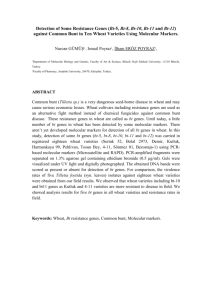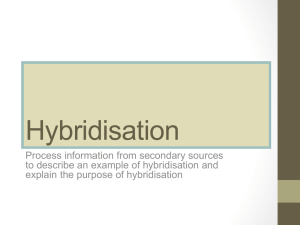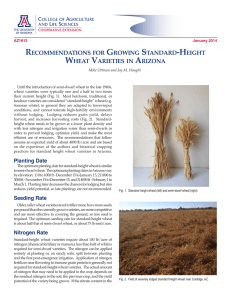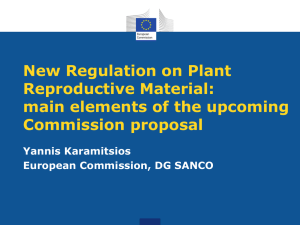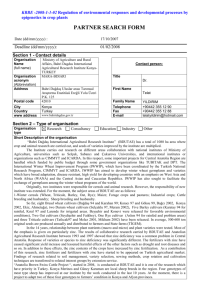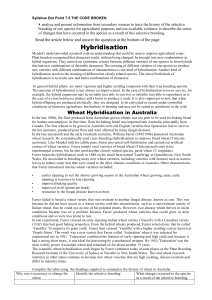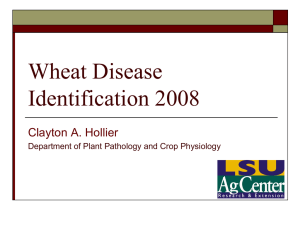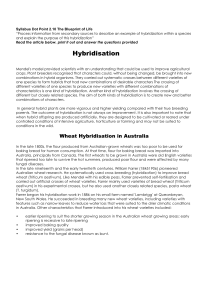Evaluation of Wheat Varieties for Disease Resistance and other
advertisement
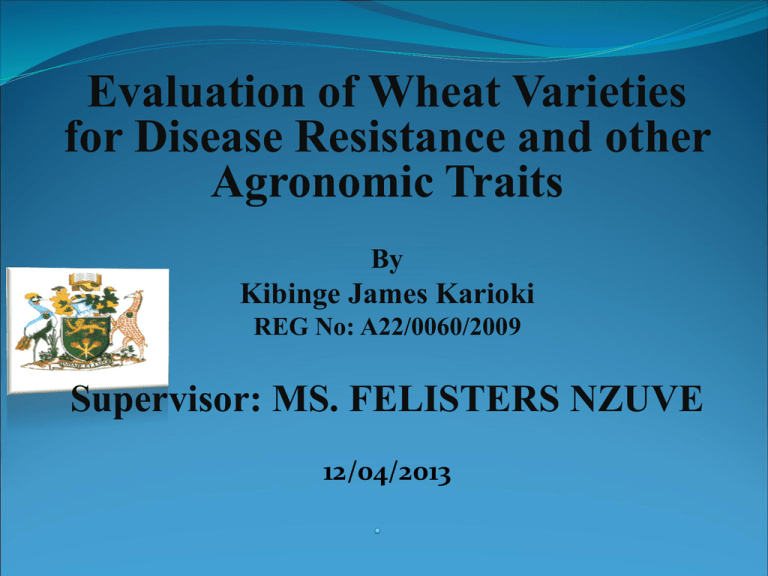
Evaluation of Wheat Varieties for Disease Resistance and other Agronomic Traits By Kibinge James Karioki REG No: A22/0060/2009 Supervisor: MS. FELISTERS NZUVE 12/04/2013 Outline of Presentation 1. Introduction 2. Statement of research problem Research hypothesis Objectives 3. Methodology 4. Work plan Introduction Wheat (Triticum aestivum) is the second most important cereal crop after maize in Kenya However, Kenya is a net importer of wheat due to low annual production of only 64400 tonnes annually Variable climatic conditions and diseases constrain wheat production Wheat improvement programs include breeding for resistance and early maturity Introduction •The common diseases include brown rust (Puccinia recondita) and black rust or stem rust (Puccinia graminis) •These diseases cause yield losses ranging from 70 to 100% especially among the resource constraint small-scale farmers Statement of research Problem There is need for farmers to use improved varieties which have high disease resistance and good agronomic traits The maturity or the stage of flowering is critical especially in areas with limited rainfall for good seed set The wheat varieties should also be of the right plant height to avoid lodging which could lower grain yield Main objective •Identifying disease resistant wheat varieties with good agronomic traits Specific objective •To Identify wheat varieties resistant to diseases •To identify early maturing varieties •To identify varieties with good plant height Hypothesis •These varieties are resistant to diseases •These varieties have good agronomic traits Site description The trial experiment will be conducted at the College of Agriculture and Veterinary Services (Upper Kabete) field station Location: Latitude 10 15` South and longitude 360 44` East; 1940m above sea level Soils: humic nitisol; Well drained, deep (>180cm), dark red to darkish brown Climate: Semi-humid with bimodal rain distribution; Long rains in mid March-May and short rain in mid October-December. The mean annual rainfall is 1006mm; Average temperature of 210C Varieties They include certified seeds of 7 wheat varieties 1. Kingbird 2. Kwale 3. Heroe 4. Duma 5. K. Hawk 6. Robin 7. Njoro BW II Experiment layout The experiments will be conducted in a randomised complete block design (RCBD) and two replications Two rows each of 1 metre will form a plot and spaced at 30cm Planting will be done using DAP 20:20:0 on fine tilth prepared plots Supplemental irrigation water will be done Weed control will be done manually through uprooting Data collection Disease severity data will be recorded as follows: Percent of rust infection on the leaves based on modified Cobb’s scale (0-100%) Roelfs scale (1992) based on host responses to infection; using "R" =resistance, MR =moderate resistance, MS = moderate susceptibility and S =full susceptibility Other agronomic data: Plant height and days to 50% flowering Data Analysis The Analysis of variance (ANOVA) will be done to determine the significance of the differences among the wheat varieties (genotypes) for the disease and other agronomic traits The least significant differences (P=0.05) will be used to compare the means Work plan ACTIVITY PERIOD Dec 2012 JAN 2013 Proposal writing Land preparation and planting Irrigation and weed control Data collection and analysis Proposal presentation Report writing Final Report presentation FEB 2013 MARCH 2013 APRIL 2013 Thank you!!!
